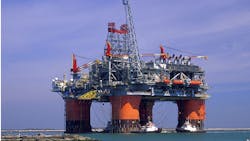How To Determine Hydraulic Pump Condition Using Volumetric Efficiency
The hydraulic pump is usually the hardest working component of a hydraulic system. And as the pump wears in service, internal leakage increases and therefore the percentage of output flow available to do useful work (volumetric efficiency) decreases. If volumetric efficiency falls below a level considered acceptable for the application, the pump will need to be changed-out. In a condition-based maintenance environment, the decision to change-out the pump is usually based on remaining bearing life or deterioration in volumetric efficiency, whichever occurs first.
Put simply, volumetric efficiency is the percentage of theoretical pump flow available to do useful work. In other words, it's a measure of a hydraulic pump's volumetric losses through internal leakage and fluid compression. It is calculated by dividing the pump's actual output in liters or gallons per minute by its theoretical output, expressed as a percentage. Actual output flow is determined using a flow-meter to load the pump and measure its flow rate.
Because internal leakage increases as operating pressure increases and fluid viscosity decreases, these variables should be stated when stating volumetric efficiency. For example, a hydraulic pump with a theoretical output of 100 L/min, and an actual output of 94 L/min at 350 bar and 40 centistokes is said to have a volumetric efficiency of 94% at 350 bar and 40 centistokes. In practice, fluid viscosity is established by noting the oil temperature at which actual pump output flow is measured and reading the viscosity off the temperature/viscosity graph for the grade of oil in the hydraulic system.
When calculating the volumetric efficiency of a variable displacement pump, it is important that internal leakage is expressed as a constant. This is best illustrated with an example. I was recently asked to give a second opinion on the condition of a large, variable displacement pump. My client had been advised that its volumetric efficiency was down to 80 percent and based on this advice, he was considering having the pump overhauled.
The hydraulic pump in question had a theoretical output of 1,000 L/min at full displacement and maximum RPM. Its actual output was 920 L/min at 300 bar and 25 centistokes. When I advised my client that the pump's volumetric efficiency was in fact 92 percent he was alarmed by the conflicting assessments. To try and explain the disparity, I asked to see the first technician's test report.
After reviewing this test report, I realized that the results actually agreed with mine, but had been interpreted incorrectly. The test had been conducted to the same operating pressure and at a fluid temperature within one degree of my own test, but at reduced displacement. The technician had limited the pump's displacement to give an output of 400 L/min (presumably the maximum capacity of his flow-tester) at maximum RPM and no load. At 300 bar the recorded output was 320 L/min. From these results, volumetric efficiency had been calculated to be 80 percent (320/400 x 100 = 80).
To help understand why this interpretation is incorrect, think of the various leakage paths within a hydraulic pump as fixed orifices. The rate of flow through an orifice is dependant on the diameter (and shape) of the orifice, the pressure drop across it and fluid viscosity. This means that if these variables remain constant, the rate of internal leakage remains constant, independent of the pump's displacement.
Note that in the above example, the amount of internal leakage in both tests was 80 liters per minute. If the same test were conducted with pump displacement set to 100 liters per minute at no load, pump output would be 20 liters per minute at 300 bar (100 - 80 = 20), all other things equal. This means that this variable pump has a volumetric efficiency of 20 percent at 10 percent displacement, 80 percent at 40 percent displacement and 92 percent at 100 percent displacement. As you can see, if actual pump output is measured at less than full displacement (or maximum RPM) an adjustment needs to be made when calculating volumetric efficiency.
Of course, in considering whether it's necessary to have the pump in the above example overhauled, the important number is volumetric efficiency at 100 percent displacement. And this was within acceptable limits. If my client had based their decision on volumetric efficiency at 40 percent displacement, they would have paid thousands of dollars for an unnecessary rebuild. And to discover six other costly mistakes you want to be sure to avoid with your hydraulic equipment, get "Six Costly Mistakes Most Hydraulics Users Make... And How You Can Avoid Them!" available for FREE download here.
About the Author
Brendan Casey Blog
Author
Brendan Casey is a war-weary and battle-scarred veteran of the hydraulics industry. He's the author of The Hydraulic Troubleshooting Handbook, Insider Secrets to Hydraulics, Preventing Hydraulic Failures, The Definitive Guide to Hydraulic Troubleshooting, The Hydraulic Breakdown Prevention Blueprint and co-author of Hydraulics Made Easy and Advanced Hydraulic Control. And when he's not writing about hydraulics or teaching it, Brendan is flat-out helping consulting clients from a diverse range of industries solve their hydraulic problems. To contact him visit his company's Website:
www.HydraulicSupermarket.com
